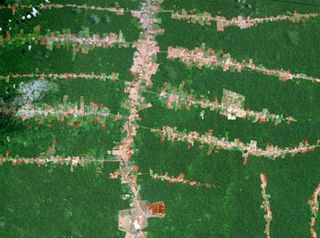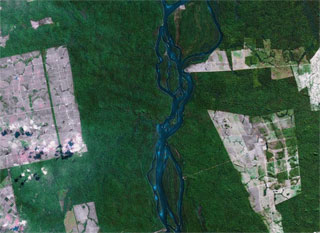Brazil to allow large-scale monitored harvesting of the Amazon
Brazil to allow large-scale monitored harvesting of the Amazon
Rhett A. Butler, mongabay.com
February 25, 2007
The International Tropical Timber Organization (ITTO) reports the Brazilian government plans to allow large-scale monitored harvesting of the Amazon rainforest. The new plan expands on an initiative proposed last year by Brazilian president Luiz Inacio Lula da Silva that would allow sustainable logging across 3 percent of the Amazon rain forest.
“In an attempt to create the first coherent, efficient forest policy for the country, the government will start to auction rights of forest harvesting in large extensions of the Amazon rainforest,” states the ITTO in its bi-monthly newsletter, Tropical Timber Market Report. “Under the plan, successful bidders will not receive land rights or the right to explore other resources besides timber. The plan is also expected to help reducing pressure on land properties in the Amazon.”
The government says that increased monitoring of the Amazon will make up for the exploitation of forest resources. Much of the Amazon is under little surveillance and illegal logging, mining, and land-clearing for cattle pasture and agriculture are important contributors to deforestation in the region.
Critics of the plan say it will open up more of the Amazon to clearing, which already claims thousands of square kilometers (miles) of forest each year. In total, Brazil has lost more than 650,00 square kilometers (250,000 square miles) or 18 percent of the Amazon rainforest since the early 1970s, mostly as a result of cutting for cattle pasture, agriculture, infrastructure development, and resettlement initiatives.
ITTO says that “the plan will only reach its objective if human and financial resources are allocated and fully available, mostly for monitoring and law enforcement.”
In conjunction with the announcement, the Brazilian Ministry of Environment said it plans to carry out a national forest inventory to survey the “natural and planted
forest cover” to help identify current and potential forest uses. The inventory will begin this year and be completed by 2011. The Ministry of Environment intends to update the survey every five years.
Meanwhile, according to Reuters, a prominent group of Brazilian Catholic bishops condemned the government for its failure to address deforestation in the Amazon. Dom Orani Joao Tempesta, Archbishop of Belem and commission head of the Brazilian National Bishops’ Council, told Reuters that the government was “absent” in combating “predatory development” in the region. The bishops expressed concern over mounting soybean farming in the region.
“The soy planting is causing the same devastating effect as did the spread of big commercial ranching in the 1960s and 1980s,” the Council’s head, Dom Odilo Scherer, was quoted as saying in O Globo newspaper.
Scherer said the government should “strictly control” the expansion of farmland.
This article used quotes an information from the ITTO, Reuters, O Globo, and previous mongabay.com articles.

